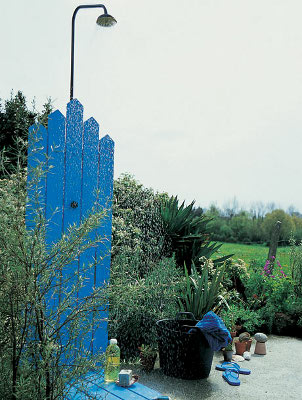
Low tech greywater treatment
 The
simplest type of greywater system is what Art Ludwig calls the drain
out back. In other words, you take the pipe from your sink or
bathtub and run it to an out-of-the-way location to leach
directly into the soil.
The
simplest type of greywater system is what Art Ludwig calls the drain
out back. In other words, you take the pipe from your sink or
bathtub and run it to an out-of-the-way location to leach
directly into the soil.
We only have running
water in one location in the house (the kitchen sink), and our original
treatment system
soon devolved into a drain out back when I didn't have enough wood
chips on hand to replace the mulch. As long as your outlet isn't
close to a stream or to a direct route into the groundwater (such as a
sinkhole), this low tech solution really isn't so bad. Yes, the
ground gets a bit swampy there, but the soil microorganisms make short
work of nutrients and germs in the water, and by the time the liquid
seeps down into the groundwater, it's pure. In most states, new
systems of this type are probably illegal, but even the regulators
don't really care as long as your system is grandfathered in and
doesn't bother your neighbors.
 An alternative extremely low
tech solution is what Art Ludwig calls "landscape direct". We use
this technique by setting our wringer
washer in the middle of the yard and simply dumping the used wash water
into the ground. A more elegant incarnation is the bathing garden
illustrated in Create
an Oasis with Greywater,
which consists of a raised, cobbled mound on which you shower,
underlain by sand to expedite drainage, and surrounded by plants to
soak up the water.
An alternative extremely low
tech solution is what Art Ludwig calls "landscape direct". We use
this technique by setting our wringer
washer in the middle of the yard and simply dumping the used wash water
into the ground. A more elegant incarnation is the bathing garden
illustrated in Create
an Oasis with Greywater,
which consists of a raised, cobbled mound on which you shower,
underlain by sand to expedite drainage, and surrounded by plants to
soak up the water.
The main problem with
low tech systems like these is loss of
efficiency. If you live in a very dry climate, every drop of
water is precious, so it's worth spending a bit more effort to ensure
your greywater ends up feeding plants. Stay tuned for the rest of
the lunchtime series (picking back up Thursday after our regular book
club discussion) for slightly higher tech, and more efficient,
greywater options.
| This post is part of our Create an Oasis with Greywater lunchtime
series.
Read all of the entries: |
Want more in-depth information? Browse through our books.
Or explore more posts by date or by subject.
About us: Anna Hess and Mark Hamilton spent over a decade living self-sufficiently in the mountains of Virginia before moving north to start over from scratch in the foothills of Ohio. They've experimented with permaculture, no-till gardening, trailersteading, home-based microbusinesses and much more, writing about their adventures in both blogs and books.
Want to be notified when new comments are posted on this page? Click on the RSS button after you add a comment to subscribe to the comment feed, or simply check the box beside "email replies to me" while writing your comment.

I have been looking into a Subsurface flow constructed wetland to preserve our greywater and make the best use of it. I would want to place a valve on each water source to allow us to switch back to the current septic field system as a backup, and have filtration for grease/sediment as well as a surge tank for overflow at the top end close to the house. Then there would be 2-3 redundant pipes routing the flow into the constructed wetland, through a subsurface sand/gravel bed and up into a pool of aquatic plants to process the "grey" out and discharge clean water at the end. I would love to hear the inventor's remarks on that type of design!
I will have to size the wetland carefully based on our water usage to insure the water coming out the end has had enough "processing". We have a decent amount of slope into woods behind our house, so my plan is to route the water through a few pools/ponds and create water-loving microclimates around them. I would rather use rainwater collection for watering the annual gardens close to the house (Zones 0-3), and use greywater as part of a semi-wild ecology.
I would have thought that a greywater system as described in the article would be much too involved for you? With the filters and grease trap &c.
What you're basically building is a small-scale sewage treatment plant, but without a disinfection stage.